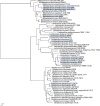Comparative genomic analysis of the multispecies probiotic-marketed product VSL#3
- PMID: 29451876
- PMCID: PMC5815585
- DOI: 10.1371/journal.pone.0192452
Comparative genomic analysis of the multispecies probiotic-marketed product VSL#3
Erratum in
-
Correction: Comparative genomic analysis of the multispecies probiotic-marketed product VSL#3.PLoS One. 2018 Aug 30;13(8):e0203548. doi: 10.1371/journal.pone.0203548. eCollection 2018. PLoS One. 2018. PMID: 30161239 Free PMC article.
Abstract
Several probiotic-marketed formulations available for the consumers contain live lactic acid bacteria and/or bifidobacteria. The multispecies product commercialized as VSL#3 has been used for treating various gastro-intestinal disorders. However, like many other products, the bacterial strains present in VSL#3 have only been characterized to a limited extent and their efficacy as well as their predicted mode of action remain unclear, preventing further applications or comparative studies. In this work, the genomes of all eight bacterial strains present in VSL#3 were sequenced and characterized, to advance insights into the possible mode of action of this product and also to serve as a basis for future work and trials. Phylogenetic and genomic data analysis allowed us to identify the 7 species present in the VSL#3 product as specified by the manufacturer. The 8 strains present belong to the species Streptococcus thermophilus, Lactobacillus acidophilus, Lactobacillus paracasei, Lactobacillus plantarum, Lactobacillus helveticus, Bifidobacterium breve and B. animalis subsp. lactis (two distinct strains). Comparative genomics revealed that the draft genomes of the S. thermophilus and L. helveticus strains were predicted to encode most of the defence systems such as restriction modification and CRISPR-Cas systems. Genes associated with a variety of potential probiotic functions were also identified. Thus, in the three Bifidobacterium spp., gene clusters were predicted to encode tight adherence pili, known to promote bacteria-host interaction and intestinal barrier integrity, and to impact host cell development. Various repertoires of putative signalling proteins were predicted to be encoded by the genomes of the Lactobacillus spp., i.e. surface layer proteins, LPXTG-containing proteins, or sortase-dependent pili that may interact with the intestinal mucosa and dendritic cells. Taken altogether, the individual genomic characterization of the strains present in the VSL#3 product confirmed the product specifications, determined its coding capacity as well as identified potential probiotic functions.
Conflict of interest statement
Figures




Similar articles
-
Taxonomy and physiology of probiotic lactic acid bacteria.Int J Food Microbiol. 1998 May 26;41(2):103-25. doi: 10.1016/s0168-1605(98)00049-x. Int J Food Microbiol. 1998. PMID: 9704860
-
Safety evaluation of HOWARU® Restore (Lactobacillus acidophilus NCFM, Lactobacillus paracasei Lpc-37, Bifidobacterium animalis subsp. lactis Bl-04 and B. lactis Bi-07) for antibiotic resistance, genomic risk factors, and acute toxicity.Food Chem Toxicol. 2017 Dec;110:316-324. doi: 10.1016/j.fct.2017.10.037. Epub 2017 Nov 5. Food Chem Toxicol. 2017. PMID: 29080807
-
Portable CRISPR-Cas9N System for Flexible Genome Engineering in Lactobacillus acidophilus, Lactobacillus gasseri, and Lactobacillus paracasei.Appl Environ Microbiol. 2021 Feb 26;87(6):e02669-20. doi: 10.1128/AEM.02669-20. Print 2021 Feb 26. Appl Environ Microbiol. 2021. PMID: 33397707 Free PMC article.
-
[Applyed aspects of molecular biology of Bifidobacteria and Lactobacillus].Zh Mikrobiol Epidemiol Immunobiol. 2006 Mar-Apr;(2):89-97. Zh Mikrobiol Epidemiol Immunobiol. 2006. PMID: 16758909 Review. Russian.
-
Comparative genomics of Bifidobacterium, Lactobacillus and related probiotic genera.Microb Ecol. 2012 Apr;63(3):651-73. doi: 10.1007/s00248-011-9948-y. Epub 2011 Oct 27. Microb Ecol. 2012. PMID: 22031452 Free PMC article. Review.
Cited by
-
Microbiome differences related to metformin intolerance among Black individuals with diabetes, a pilot cross-sectional study.Metabol Open. 2023 Sep 15;20:100256. doi: 10.1016/j.metop.2023.100256. eCollection 2023 Dec. Metabol Open. 2023. PMID: 38115865 Free PMC article.
-
Acute gastroenteritis-changes to the recommended original oral rehydrating salts: a review.Front Pediatr. 2023 Dec 18;11:1294490. doi: 10.3389/fped.2023.1294490. eCollection 2023. Front Pediatr. 2023. PMID: 38192370 Free PMC article. Review.
-
Comparative genome analysis of Lactobacillus mudanjiangensis, an understudied member of the Lactobacillus plantarum group.Microb Genom. 2019 Sep;5(9):e000286. doi: 10.1099/mgen.0.000286. Epub 2019 Aug 1. Microb Genom. 2019. PMID: 31368886 Free PMC article.
-
Targeting gut microbiota dysbiosis in inflammatory bowel disease: a systematic review of current evidence.Front Med (Lausanne). 2025 Feb 18;12:1435030. doi: 10.3389/fmed.2025.1435030. eCollection 2025. Front Med (Lausanne). 2025. PMID: 40041456 Free PMC article.
-
Probiotic colonization dynamics after oral consumption of VSL#3® by antibiotic-treated mice.Microbiome Res Rep. 2022 Jul 19;1(4):21. doi: 10.20517/mrr.2022.07. eCollection 2022. Microbiome Res Rep. 2022. PMID: 38046906 Free PMC article.
References
-
- Hill C, Guarner F, Reid G, Gibson GR, Merenstein DJ, et al. (2014) Expert consensus document. The International Scientific Association for Probiotics and Prebiotics consensus statement on the scope and appropriate use of the term probiotic. Nat Rev Gastroenterol Hepatol 11: 506–514. doi: 10.1038/nrgastro.2014.66 - DOI - PubMed
-
- Kankainen M, Paulin L, Tynkkynen S, von Ossowski I, Reunanen J, et al. (2009) Comparative genomic analysis of Lactobacillus rhamnosus GG reveals pili containing a human- mucus binding protein. Proc Natl Acad Sci U S A 106: 17193–17198. doi: 10.1073/pnas.0908876106 - DOI - PMC - PubMed
-
- Douillard FP, Ribbera A, Kant R, Pietilä TE, Järvinen HM, et al. (2013) Comparative genomic and functional analysis of 100 Lactobacillus rhamnosus strains and their comparison with strain GG. PLoS Genet 9: e1003683 doi: 10.1371/journal.pgen.1003683 - DOI - PMC - PubMed
-
- Nissilä E, Douillard FP, Ritari J, Paulin L, Järvinen HM, et al. (2017) Genotypic and phenotypic diversity of Lactobacillus rhamnosus clinical isolates, their comparison with strain GG and their recognition by complement system. PLoS One 12: e0176739 doi: 10.1371/journal.pone.0176739 - DOI - PMC - PubMed
-
- Tytgat HL, Douillard FP, Reunanen J, Rasinkangas P, Hendrickx AP, et al. (2016) Lactobacillus rhamnosus GG outcompetes Enterococcus faecium via mucus-binding pili: Evidence for a novel and heterospecific probiotic mechanism. Appl Environ Microbiol 82: 5756–5762. doi: 10.1128/AEM.01243-16 - DOI - PMC - PubMed
Publication types
MeSH terms
LinkOut - more resources
Full Text Sources
Other Literature Sources
Miscellaneous

